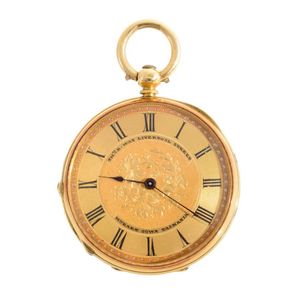18ct Gold Quarter Repeating Verge Watch by S. Gallonier
You must be a subscriber, and be logged in to view price and dealer details.
Subscribe Now to view actual auction price for this item
When you subscribe, you have the option of setting the currency in which to display prices to $Au, $US, $NZ or Stg.
- Movement - The technical name for the workings of a clock or watch, and does not include the dial or case.
- Chapter Ring - A separate metal plate on the face of a clock, on which the numerals for the hours and sometimes parts of the hours, are displayed, usually wheel shaped and sitting on top of the dial plate. The chapter ring is often a feature of the clock and can be silvered or enamelled to stand as a contrast to its background. The hours are usually shown in Roman numerals, although in the late 19th and earlt 20th century, Arabic numerals became fashionable.
- Circa - A Latin term meaning 'about', often used in the antique trade to give an approximate date for the piece, usually considered to be five years on either side of the circa year. Thus, circa 1900 means the piece was made about 1900, probably between 1895 and 1905. The expression is sometimes abbreviated to c.1900.
- Fusee - The fusee movement was used in clocks and pocket watches from the mid 17th century. The fusee is a cone shaped drum within the works that is linked to the barrel of the spring, usually by a length of chain.
As the mainspring loses its tension over time, the cone shaped barrel compensates for this by increasing the tension, by pulling the mainspring tighter, thus ensuring the time remains constant.
Use of the fusee in clocks was superseded by the "going barrel" in the mid 19th century and for pocket watches at the beginning of the 19th century.
The fusee continued to be used in marine chronometers until the 1970s.
This item has been included into following indexes:
Visually similar items

A lady' s gold openface pocket watch, circa 1895. 35 mm. Key wind. Unsigned movement. 18ct yellow gold.

A rare early antique Australian ladies open face gold pocket watch, key wind and set movement, circular gold dial with Roman numerals, signed dial, movement and curvet, Thos. B. Way Liverpool Street Hobart Town Tasmania, case signed G. Chopard, 18ct gold c

An open face gold pocket watch, key wind movement, circular golden dial with Roman numerals, 18ct gold case, hallmarked London 1834, maker cap, 38 mm diameter

A French quarter repeater fusee verge pocket watch, Curvet and movement and signed Breguet and Files, circular 18ct gold fancy engraved dial with Roman numerals, with engraved hunting scene depicting stag and hound, 18ct gold case, diameter 50 mm, circa 18
